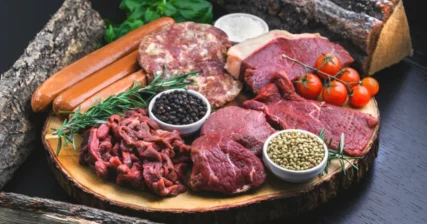Listen on: Apple Podcasts | Spotify
Over the past two decades, we’ve seen a consistent effort to vilify red meat consumption while extolling the benefits of a plant-based diet.
I believe that once we are through the COVID Circus, we’ll find the consumption of red meat in the crosshairs of nutrition, climate, and social justice conversations. And just like with COVID, ideologies and agendas will create “the truth,” rather than relying on facts and scientific evidence.
With enough propaganda, the public will get wooed into a plant-based diet in the midst of a war on meat.
Rather than tackling this meaty topic all at once, I’ll separate fact from fiction through multiple, bite-sized posts. That way, the facts will be more digestible, like a perfectly cooked porterhouse steak.
And in case you were wondering about how much red meat I personally eat, I eat a lot of bison, but no beef. I’m allergic to it. I believe I have Alpha-Gal Syndrome, which causes a beef allergy. It occurs after you get bit by a Lone Star tic. If I eat beef, I feel like I had food poisoning for the following 36 hours, or so. I do miss it.
I point that out to say that I’m not on the payroll of the Beef Council, and don’t even eat it myself.
In this post, I’ll address the claim that eating red meat causes heart disease or diabetes. Let’s dig in.
What “Red Meat “ Is and Isn’t
According to the Dietary Guidelines for Americans:
Meat, also known as red meat, includes all forms of beef, pork, lamb, veal, goat, and nonbird game (e.g., venison, bison, and elk). Poultry includes all forms of chicken, turkey, duck, geese, guineas, and game birds (e.g., quail and pheasant). Meats and poultry vary in fat content and include both fresh and processed forms. Lean meats and poultry contain less than 10 g of fat, 4.5 g or less of saturated fats, and less than 95 mg of cholesterol per 100 g and per labeled serving size (e.g., 95% lean ground beef, pork tenderloin, and skinless chicken or turkey breast). Processed meats and processed poultry (e.g., sausages, luncheon meats, bacon, and beef jerky) are products preserved by smoking, curing, salting, and/or the addition of chemical preservatives.
Dietary Guidelines for Americans, 2015-2020
To reiterate:
- “Red meat” is an umbrella term that includes “all forms of beef, pork, lamb, veal, goat, and nonbird game (e.g., venison, bison, and elk.)”
- The phrase processed meat includes “processed meats and processed poultry (e.g., sausages, luncheon meats, bacon, and beef jerky) are products preserved by smoking, curing, salting, and/or the addition of chemical preservatives.”
These statements don’t just apply to the Dietary Guidelines. They also apply to the way researchers assess “red and processed meat” consumption.
Why is this important to understand? Because unprocessed and processed meats are very different. On top of that, many processed meats, such as sausage or bacon are often found on top of pizza, in frozen meals, and as ingredients in fast foods. When researchers ask study participants about the processed meats they eat, they use examples like pizza to help them count their processed meat servings.
There’s an enormous difference between freshly-made pork sausage, and preserved pork sausage included as part of a frozen pizza.
The Dietary Guidelines document goes on to say:
For those who eat animal products, the recommendation for the protein foods subgroup of meats, poultry, and eggs can be met by consuming a variety of lean meats, lean poultry, and eggs. Choices within these eating patterns may include processed meats and processed poultry as long as the resulting eating pattern is within limits for sodium, calories from saturated fats and added sugars, and total calories.
Dietary Guidelines for Americans, 2015-2020
In essence, their perspective is that fat and sodium are the problem, so you can eat as much fat-free, highly-processed meat as you want, provided it’s low in fat. That sort-of contradicts the recommendations to avoid processed meats, but our government is notorious for contradictions. I’ve outlined many of them in my COVID-19 collection of articles. But let’s stay focused on red meat for now, being that it’ll surely be a big topic in the next couple of years.
The approach to vilifying meat involves a few ways of misleading the public:
- Use of associative data, not causal data. For example, people who eat more red meat have more cardiovascular disease (an association) but they’re also more likely to smoke, consume junk food, drink more alcohol, etc. (all likely causal factors for CVD), meaning red meat is guilty by association, not causation.
- A perpetuation of the myth that fat is bad for you and that people should eat a low-fat, low-salt diet. Again, this belief stems from population-based data, not clinical trials. Clinical trials have refuted the idea that low-fat diets improve cardiovascular risk or the risk of developing type II diabetes for years.
- The lumping together of unprocessed cuts of beef, bison, elk, etc., with highly processed meat eaten in combination with other junk foods to classify all red meat under the same umbrella. This is akin to labeling all heterosexual, white males as oppressive, homophobic, transphobic, racist bigots because a tiny percentage of the population actually are. The others just might have a different moral framework than those pushing these countercultural ideologies.
By the way, I’m weaving in a few political analogies because once you see how the policymakers and the media mislead people in one area of our lives (nutrition), it isn’t hard to see how they do it in other areas (public education, the COVID Circus, etc.)
As it relates to red meat and cardiometabolic disease, the important question is, “What does the data say when you separate unprocessed red meat from the junk? Does red meat still affect cardiometabolic disease risk?
What do randomized studies show when it comes eating red meat?
Last year, Lauren E O’Connor and four other researchers published a meta-analysis titled, Effects of Total Red Meat Intake on Glycemic Control and Inflammatory Biomarkers: A Meta-Analysis of Randomized Controlled Trials, in which they answered that very question.
The team reviewed randomized, controlled trials that tested how cardiometabolic markers changed with red meat consumption.
If the researchers went into the analysis with any sort of bias, it was on the side of expecting red meat consumption would increase risk.
As they explained in their paper’s introduction:
Based on conclusions from observational studies linking higher red meat intake to an increased risk of diabetes, we hypothesized that higher total red meat intake would negatively impact changes in glycemic control and inflammation, which are clinical biomarkers associated with T2DM risk. This meta-analysis was designed to complement previously published meta-analyses that assessed the effects of total red meat intake on changes in blood lipids, lipoproteins, and blood pressures, and to expand the understanding of how total red meat intake affects comorbid cardiometabolic disease risk factors.
O’Connor LE, et al.
It turns out, their hypothesis was wrong. Here’s how they summarized their findings in the discussion portion of the paper:
We hypothesized that total red meat intake would have a negative impact on these outcomes, based on positive associations between unprocessed and processed red meat intake and diabetes incidences. However, our results showed no effect of total red meat intake on fasting glucose, insulin, HOMA-IR, HbA1c, CRP, IL-6, or TNF-α concentrations from RCTs of up to 16 weeks in duration.
O’Connor LE, et al.
So, according to “the science,” red meat does not contribute to increased cardio metabolic disease risk. That doesn’t mean that eating more lowers risk either. According to this particular meta-analysis, it had no effect. That’s quite different from what ideological alarmists will tell you about eating red meat.
Now you know the truth, even if some of them aren’t willing to understand it.
It would be really interesting to see what happens when people intentionally increase consumption of unprocessed red meat. To my knowledge, no research like that exists.
Higher-protein diets consistently improve metabolic markers, body composition, lean mass, blood sugar control, satiety, and immune function.
It would be interesting to see what happens when a larger portion of a high-protein diet comes from red meat. Outside of anecdotal effects from Carnivore Diet enthusiasts, there isn’t much evidence one way or the other.
Summary
Red meat has been a nutrition punching bag for special interests for decades now. Its reputation is a perfect example of the adage, “If you tell a lie often enough, it eventually becomes the truth.”
As it relates to cardiovascular disease or type II diabetes, the research shows it has no effect on increasing risk.
The meat doesn’t raise risk. The fat in the meat doesn’t raise risk either. But when people pair it up with boatloads of carbs, the combination of fat and carbs may very well set someone up for a heart attack or the loss of an ankle.
But again, it isn’t the meat nor the fat, it’s what people eat with it that leads to major health problems.
When you look at populations of people who eat more red meat and those who eat less, and then look for rates of heart disease and type II diabetes, you very well might find associations hinting at the idea that eating red meat raises heart disease risk.
The problem is, association never shows causation. The reason is that there are always other variables that play a role in associations.
This rings true in nutrition, claims of systemic racism, crime, income inequality, and numerous other societal issues.

Feel Better Fast. Guaranteed.
Energy+, EDGE, and MentaBiotics make up the Happy Juice supplement stack, with ingredients clinically proven to:
- decrease anxiousness scores by 55%
- decrease irritability scores by 60%
- decrease fatigue by 64%
- decrease anger 54%
- decrease tension by 45%
- decrease confusion by 43%
- decrease overall distress by 49%
- increase good bacteria by 70%
- decrease negative mood by 105%
- increase positive mood by 211%
Photo by Madie Hamilton on Unsplash



